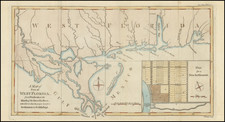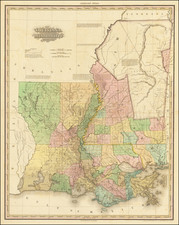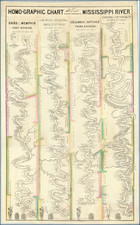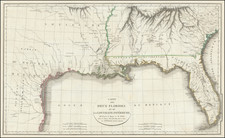Mapping The Changes in the Mississippi Delta in the mid-19th Century
This 1852 map, produced by the U.S. Coast Survey under the supervision of A. D. Bache, presents a detailed reconnaissance of the passes of the Mississippi River Delta in Louisiana. It highlights the geographical changes that have occurred since 1839, providing a vital record of the shifting landscape of one of America's most significant river deltas.
The map is composed of four distinct sub-maps, each focusing on different segments of the delta:
-
South West Pass:
- This sub-map illustrates the southwestern entrance to the Mississippi River. It details the various sandbars, channels, and depth soundings crucial for navigation. The intricate network of water passages indicates the complex nature of this entrance, which was a critical point for maritime activities.
-
Pass à l'Outre:
- Located to the northeast of the South West Pass, this section shows the navigational routes and depth measurements. Blind Bay is prominently featured, providing insights into the bay's layout and the surrounding marshlands.
-
Garden Island Bay:
- This sub-map focuses on the southeastern region of the delta, known as Garden Island Bay. It highlights the bay's topography, channels, and surrounding islands. This area is depicted with great detail, showcasing the numerous small islands and waterways that define its geography.
-
Delta of the Mississippi:
- The central portion of the delta is covered in this sub-map, illustrating the confluence of various river branches as they spread out into the Gulf of Mexico. It provides a comprehensive view of the delta's main channels and the intricate network of distributaries.
At the center of the map, a section dedicated to sailing directions offers crucial information for mariners navigating these treacherous waters. It includes detailed instructions on how to approach and traverse the various passes, highlighting hazards such as shifting sandbars and strong currents. The sailing directions are a vital resource for ensuring safe passage through the ever-changing delta.
The Mississippi River Delta has always been a dynamic and challenging environment for navigation due to its constantly shifting channels and sediment deposition. By the mid-19th century, accurate mapping of this region was essential for safe and efficient maritime travel, particularly given the delta's significance as a major conduit for trade and transportation. The work of the U.S. Coast Survey, as exemplified by this map, played a crucial role in improving the safety and reliability of navigation in these waters.
This 1852 map of the Mississippi River Delta, with its detailed sub-maps and comprehensive sailing directions, provides an invaluable snapshot of the region's geography during a period of significant change. It stands as a testament to the meticulous efforts of the U.S. Coast Survey in enhancing navigational safety and understanding of one of America's most vital waterways.











![[ John Law / Mississippi Bubble ] De laggende Law, de treurende actionist met de smekende Mercurius (Law laughing, the shareholders mourning, and Mercury begging.)](https://storage.googleapis.com/raremaps/img/small/104296.jpg)


